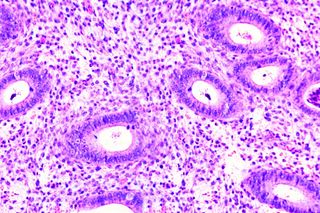
Myths, Stigma Exaggerate Effects of Endometriosis on Fertility
A diagnosis doesn’t mean you’re infertile.

“I come from a typical Gujarati family, we are into sports, well educated, well traveled and everything, but people talk nonsense,” says Puja Gandhi, 37, who was diagnosed with endometriosis last year. “There’s absolutely no empathy shown, in fact people make statements like, ‘Oh, then you’ll have to cut off your ovaries.’ ‘Oh, you’ll have to get a hysterectomy done before time.’ ‘Oh, but you’ve not even had children — oh, then you should have had children! You know, this is why we told you get married and have children.’”
Not only does she deal with the physical pain caused by her endometriosis, which had spread to her intestines undetected, Gandhi says she struggles with the myths and stigma around the condition’s relationship to fertility.
Endometriosis is a condition characterized by abnormal growth of endometrial cells. Endometrial cells are typically found within the uterus; they form the endometrium, which grows during the menstrual cycle and is expelled during menstruation if no pregnancy occurs. In women with endometriosis, endometrial tissue grows outside the uterus, too, potentially spreading over the Fallopian tubes, ovaries, bladder, vagina, bowel, rectum, and other organs. As the misplaced endometrial cells have nowhere to go — unlike the tissue inside the uterus, which is expelled during menstruation if no pregnancy occurs — they can cause pain, and eventually form scar tissue. Since endometrial cells are governed by the body’s natural cycle of hormonal changes, the primary symptom is pain, though not all women with endometriosis experience this.
Fertility problems due to endometriosis typically only occur when endometrial growth has damaged the Fallopian tubes, ovaries, or uterus, or when it triggers an inflammatory response by the immune system that inhibits pregnancy, says Dr. Mukesh Agrawal, an infertility specialist from Mumbai.
Endometriosis is a relatively common conditionthat occurs among women all over the world — one in every 10 women globally, according to The American Congress of Obstetricians and Gynecologists.
However, endometriosis might be much more common than it is diagnosed, says Agrawal. While many women with endometriosis may suffer from symptoms of pain, which can manifest during periods, urination and/or intercourse, others may not show any symptoms at all. Some may even appear to have mild symptoms which can easily be misconstrued for something else. A diagnosis typically occurs only when women seek help for pain that becomes regular and unbearable — or if they are having difficulty getting pregnant, Agrawal says, which may drive the unwarranted belief that endometriosis equals infertility.
Endometriosis is a highly individualized condition, he explains, affecting each woman differently, affecting different parts of the body, and producing different symptoms.
It is measured in stages of endometrial tissue spread, but these stages don’t have any association with fertility complications or even symptoms; one woman with Stage 4 endometriosis could have no pain and no difficulty getting pregnant, while another woman with Stage 1 endometriosis could experience one or both of those effects.
“I was already pregnant when I discovered that I did have endometriosis,” recalls Hufrish Bahl, 50. “But after that, it was difficult for me to basically conceive. Though I did conceive after that, too.”
There are no automatic consequences for every endometriosis case, as there is no ‘textbook’ progression of endometrial cell growth. It is very possible to get pregnant with the condition, Agrawal stresses, and only in extreme cases may couples need to opt for IVF.
Specialists have a grading system to evaluate how much a woman’s endometriosis may affect her chances of getting pregnant, but since many women aren’t diagnosed with the condition until they already have difficulty getting pregnant, few predictions are made.
Once doctors do know the extent of a woman’s endometriosis — typically only detected through laparoscopy or an MRI — they can offer guidance around fertility. Generally, women with endometriosis who have trouble getting pregnant, are treated with a laparoscopic surgery to clear the excess endometrial growth. Following this kind of surgery, Agrawal says, the chances of conception are highest in the first six to 12 months.
For women who get a laparoscopic removal of their endometriosis, about one-third may get a recurrence. Pregnancy and breastfeeding, which interrupt the menstrual cycle fluctuation of hormones that drive endometrial growth, lower the chance of recurrence. However, these are not sure-shot ways to eliminate the condition; in some cases it may recur, depending on various factors, including genetic disposition.
“After my pregnancies it [endometriosis] had just become worse, because my Fallopian tubes had become damaged over a period of time,” adds Hufrish, who eventually had to get a laparoscopy, and later had to get her ovary removed at 40.
If there is one conclusion to be drawn about endometriosis and fertility it is that there is no norm. Endometriosis does not always result in difficulty conceiving or infertility, let alone a hysterectomy or oophorectomy (removal of ovaries); it depends from case to case.
Agrawal encourages women to approach a specialist if they experience excessive period pain or pain during sexual intercourse, to prevent delay in a possible diagnosis, and encourages doctors to explain the condition thoroughly to combat the stigma surrounding it.
“It is the doctor’s duty to explain in detail, […] what the diagnosis means, what it has implications for the lifetime, for the fertility, for the menstrual pain, for the sexual function,” he says. “So it has to be empathetic counseling for the first time. Because you may explain too much and nothing may happen and she may get unnecessarily disturbed, and you may explain less and she may not understand.”
Angelina Shah is a staff writer with The Swaddle. In her previous life she was a copywriter in advertising. She has a penchant for reading, singing, travelling and being obsessed with superheroes.
Related


Study Finds Women Become Less Stressed With Age
